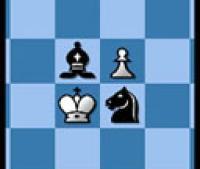
Book Review: Modern Ideas
The full title of this book by I. A. Horowitz is “Modern Ideas In The Chess Openings, ” but that is way too long for this review’s title, so we’ll just call it “Modern Ideas,” shall we? In this case, you can pretty much judge a book by its cover. It is, in fact, a text describing modern chess openings. In a stroke of serendipity, an acquaintance lent me Modern Ideas, and I recently reviewed Yasser Seirawan’s Winning Chess Openings, so this is the perfect time for me to compare the two books.
Modern Ideas was published in 1953 so the term “modern” is somewhat relative in this case. I’m not sure from when the term originated, but these days it really just describes a particular era in chess history rather than a proclamation of anything new to the chess world.
I haven’t yet had the time to play though all the examples, but all these openings were covered in Winning Chess Openings. So, I am at least familiar with them, and thusly will I stick to a treatment of Horowitz’ narrative rather than a blow-by-blow of each opening.
I will say right off that I have an issue with this book: It uses descriptive notation rather than algebraic. There’s nothing inherently wrong with this mind you, but I, like many readers, are more adept at reading algebraic notation. The information is all there, it just slows things down for those of us not schooled in the descriptive. Of course, this is merely a consequence of the era in which Modern Ideas was published, but it does make the reading of it a bit of a slog for us descriptively challenged folks.
An interesting part of this book is what Horowitz refers to as “chess movies.” These are chess games that are narrated both in text and images with the snapshots of the board displaying positions after every few moves of the players. This is quite useful and very effective. The reader needs to visualize only a few moves between each snapshot, so it’s a fairly simple act to follow along without having to resort to a board or computer program. As a side benefit, even if you are playing along with a board and chess set, life is made a bit easier by way of the “movie frames” as you can quickly be sure that you haven’t made any errors at the board and easily correct any mistakes that you do make. These sorts of errors are the bane of my existence so I appreciate the help from Horowitz.
Like I said earlier, this text doesn’t cover any openings that I haven’t previously (albeit not yet in depth) studied, but it is certainly instructive to get a second opinion. While Seirawan will give several variations and let the reader know which variation he prefers, Horowitz will not say which variations he prefers, but rather explain the feelings of other chess leaders. Horowitz also somewhat emphasizes which openings would most benefit players of which temperament rather than merely proclaiming which variations are best in the absolute sense.
Horowitz certainly covers each opening in more detail than Seirawan, but this isn’t surprising considering that this book covers far fewer openings than does the Seirawan text. In fairness, Seirawan often suggests finding longer treatments of specific openings, and Modern Ideas fills that void to some extent.
At the end of each chapter Horowitz gives “conclusions and recommendations” for the described opening. If you are already familiar with these openings, a quick flip through the book reading only these sections will probably reward you with something to ponder at the very least.
If nothing else, this book is interesting for its historical perspective. Horowitz wrote this book before the full onslaught of the computer age and it’s interesting to compare it to texts written with the benefit of computer analysis.
Props go out to Jim for lending me Modern Ideas In The Chess Openings.
As always, I’m Stick, and I’ll see you on the gridiron.
This review, other ramblings, and the famous Stickmen photocomics can be found at Stickmen On The Gridiron.






